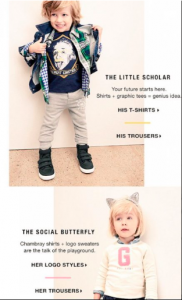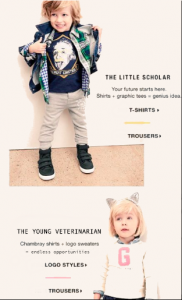Original Ad and the Problems
 This original advertisement from Gap Kids demonstrates the essentialist and reductive portrayal of roles commonly seen in society and specifically, higher education. From a young age, kids are divided and assigned roles within our society. This ad shows the gender divide within society and the expectation imposed on our youth in which little boys are encouraged to pursue higher education and women are expected to focus purely on social endeavours.
This original advertisement from Gap Kids demonstrates the essentialist and reductive portrayal of roles commonly seen in society and specifically, higher education. From a young age, kids are divided and assigned roles within our society. This ad shows the gender divide within society and the expectation imposed on our youth in which little boys are encouraged to pursue higher education and women are expected to focus purely on social endeavours.
The little boy pictured above holds the title ‘the little scholar’ along with a saying just below that reads: ‘your future starts here’. These two phrases, along with his shirt of Albert Einstein, implies that he has great potential in education and will make significant contributions to society as an academic. The equation listed below ‘t-shirts + graphic tees = genius idea’ acts as a representation of male privilege prevalent within society. For simple items such as t-shirts to result in ‘genius ideas’ parallels the benefits men experience reinforced by “social norms based on patriarchal design and historical binary developed by and for men” (Case, Hensley, & Anderson, 2014).
The little girl in the advertisement has the title ‘the social butterfly’ as well as the saying ‘chambray shirts + logo sweaters are the talk of the playground’ just below. These phrases parallel how women are reduced to ‘social butterflies’ and are not encouraged to pursue higher education. Although there are currently as many or more women in all education levels, women continue to face bias and barriers in specific fields such as mathematics and sciences” (Martinho, Albergaria-Almeida, & Dias, 2014). This bias is promoted by the lack of successful academic female representation and can become ingrained into the identities of girls as they grow up.
It is imperative that we do not restrict young boys and girls to societal norms but instead, push them to explore their own interests. This can help reduce the bias and faced by women in higher education and certain academic fields such as mathematics and science.
Jammed Ad

In the jammed ad, I chose to change the equations and change the title of the girl. I have also removed the pronouns of each kid. The titles should be equally as aspirational. This is why changed the title beside the bottom child to ‘the young veterinarian’ due to the professional outfit and love of cats as identified by the cat ears above. This new title provides the same amount of aspirational encouragement as ‘the little scholar’ for the little boy.
Replacing these titles gives both boys and girls representation of success in professional careers and demonstrates our confidence in them. This can increase their self-confidence in their academic abilities. It has been seen that confidence and a positive environment in young children can drastically increase their academic performances (Federicova, Pertold, & Smith, 2018).
I have also replaced the phrase below ‘the young veterinarian’ to ‘chambray shirts + logo sweaters = endless opportunities’. This is to show young girls that they should not be restricted by any molds imposed on them. They are not to be reduced to ‘social butterflies’ but are capable contributors to society.
Finally, I took out the pronouns ‘his’ and ‘her’ to promote gender neutral clothing. This is to reduce the stigma surrounding what is deemed appropriate for boys and girls to wear.
With the power of social media and the enormous reach of advertisements within current society, we must be careful about what messages our sent to our youth. It is imperative that from young ages, we demonstrate equal opportunities for all genders and do not portray reductive roles.
GRSJ300 – Rowan Harris – Culture Jam Assignment
References:
Case, K. A., Hensley, R., & Anderson, A. (2014). Reflecting on Heterosexual and Male Privilege: Interventions to Raise Awareness. Journal of Social Issues, 722-740.
Federicova, M., Pertold, F., & Smith, M. L. (2018). Children left behind: self-confidence of pupuls in competitive environments. Education Economics, 145-160.
Martinho, M., Albergaria-Almeida, P., & Dias, J. T. (2014). Cooperation And Competitiveness In Higher Education Science: Does Gender Matter? Procedia – Social and Behavioural Sciences, 554-558.